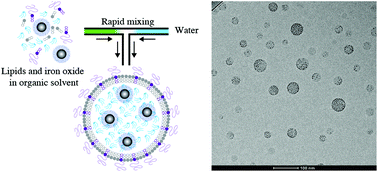Rapid synthesis of lipid nanoparticles containing hydrophobic inorganic nanoparticles†
Abstract
A straightforward “bottom-up” synthesis is described for efficient entrapment of inorganic hydrophobic nanoparticles (HNPs) consisting of iron oxide, gold, or quantum dots within the hydrophobic core of lipid nanoparticles (LNPs). These LNPs consist of hydrophobic “core” lipids such as triolein surrounded by a monolayer of amphipathic “surface” lipids, such as phosphatidylcholine and polyethylene-glycol-lipid. It is shown that rapid, controlled mixing of HNPs, core lipids and surface lipids in an organic solvent with an aqueous phase resulted in stable, monodisperse LNPs containing HNPs (LNP-HNP). This method allows 40-fold more hydrophobic iron oxide nanoparticles (IONPs) to be entrapped within an LNP than previous methods and can be readily extended to encapsulate other HNPs. The LNP-HNP diameter can be modulated over the range of 35–150 nm by varying the flow rate during particle synthesis or by varying the core-to-surface lipid ratio. LNP–IONPs can be generated using a variety of “core” lipids, including other triglycerides as well as cholesteryl-palmitate and tocopherol. Finally, it is shown that LNP–IONPs are accumulated in the liver, resulting in enhanced contrast for in vivo MRI. It is concluded that the bottom-up approach for encapsulating HNPs within LNPs has advantages of homogeneity, reproducibility and stability required for biomedical applications.



 Please wait while we load your content...
Please wait while we load your content...